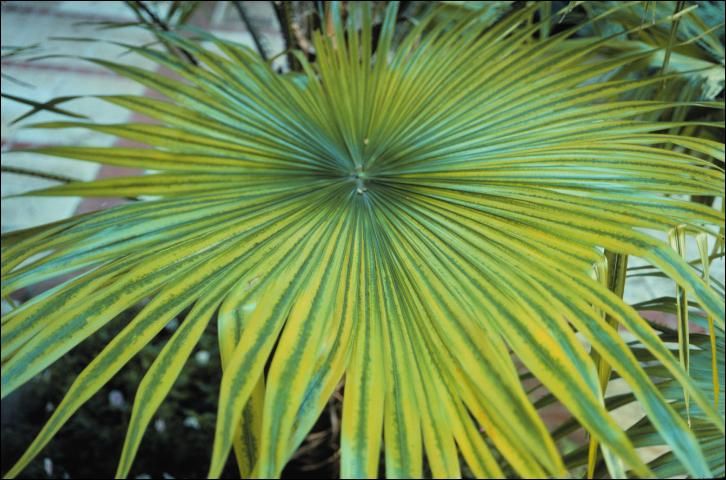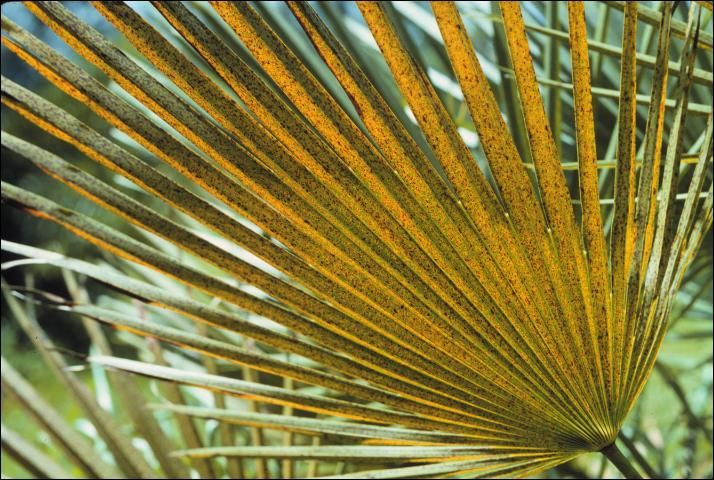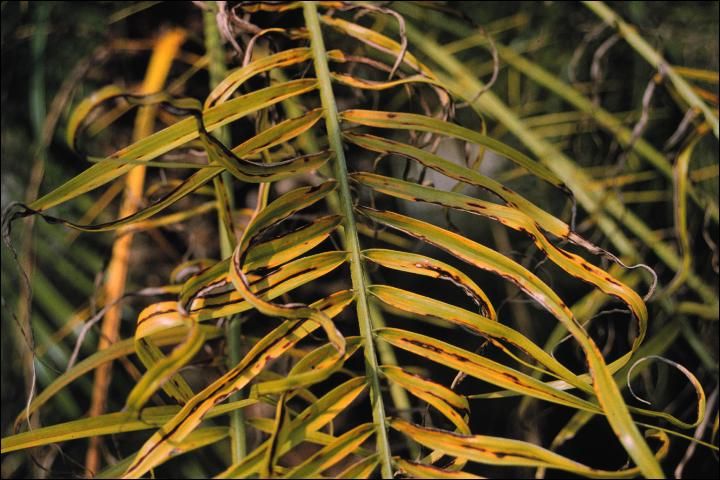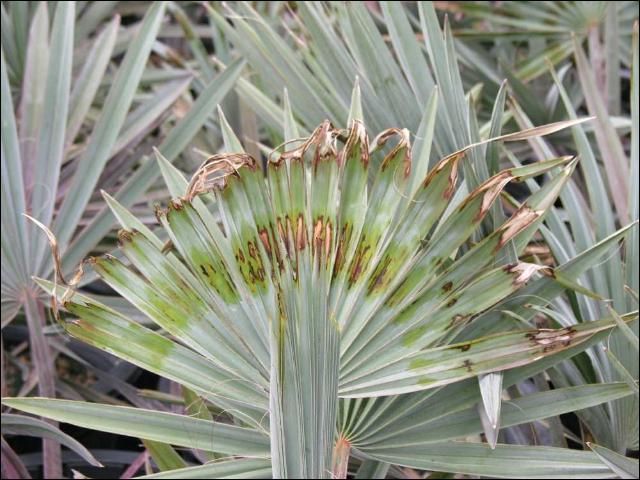One of the most common occurrences with palms is the unsightly yellow appearance that many display. So, why are palms yellow?
Palm Nutrient Deficiencies
Nutrient deficiencies are some of the most common causes of yellow palm fronds. So, let’s take a look at some common nutrient issues that palms experience, what they can look like on the palm, and causes.
Magnesium (Mg)
- Nutrient: Magnesium (Mg). One of the most common deficiencies in palms.
- Appearance: You will easily identify this when you see a light-yellow color on the outer margins of older or lower fronds of the palm and through the middle of the canopy. While the margins turn yellow, you will notice the center of the leaves will stay green.
- Cause: This can be caused by too much potassium.


Photo credit: T.K. Broschat, UF/IFAS, https://edis.ifas.ufl.edu/publication/EP266
Potassium (K)
- Nutrient: Potassium (K).
- Appearance: You will notice this on the older leaves as well. You may also notice the speckling on the leaves and the yellow-orange color with necrosis on the leaf tip as recognizable symptoms. The dead tips may also be curly.
- Cause: This is another deficiency that is caused by too much of another nutrient. In this case it is too much nitrogen, like is found in turf fertilizer that causes the potassium deficiency.


Manganese (Mn)
- Nutrient: Manganese (Mn). Not to be confused with magnesium (Mg). Sometimes this deficiency is referred to as “frizzle top” because of the frizzle appearance.
- Appearance: You will notice chlorosis or yellowing on the new leaves and smaller leaves. It is most severe on the base of the leaf and you might see longitudinal streaks on leaves.
- Cause: This is caused by high pH in soils.


Boron (B)
- Nutrient: Boron (B).
- Appearance: You will always see this showing on the new leaves. They will show an “accordion” appearance. Another very obvious symptom is the trunk bending or leaves growing in a downward direction. You may also notice the spear leaf does not open.
- Cause: Boron deficiency can be caused by not enough B in the soil or is easily leached through soil, like after a heavy rain causing a temporary leach of the available B from the root zone. This can be corrected with 2-4 oz. of soluble boron mixed in 5 gallons of water and apply as a drench around the palm. It can take five months to see a correction of boron deficiency.


Remember that correcting nutrient deficiencies can take anywhere from 6 months to 2-3 years to correct. This means the palm has to regrow completely healthy fronds that are not exhibiting nutrient deficiencies.
Appropriate Palm Fertilizer
So, when looking for a palm specific fertilizer what should you look for? Ideally palm fertilizers should be comprised of an 8-2-12+4Mg or an 8-0-12+4Mg. It is recommended to use a fertilizer that has the nitrogen, potassium, and magnesium in a slow release form and many of the micronutrients should be in a water soluble form. Much of the native soils in central Florida are abundant in phosphorus and so it does not need to be applied. That is why an 8-0-12+4Mg will be appropriate to avoid applying it when it is not needed. When we apply nutrients that cannot be taken up they become pollutants that can have negative impacts on the environment, especially our water resources.
Know Your Local Fertilizer Ordinance
Be sure you know your local fertilizer ordinance as well. Throughout Central Florida, different counties and cities may have different restrictions. If you live where there are restrictive periods, often called blackout periods, where nitrogen and phosphorous cannot be applied (often in the summertime) you may want to use a 0-0-12+4Mg during that time. To find your local fertilizer ordinance, use the Florida-Friendly Landscaping™ Florida Fertilizer Ordinances web app.
Palm Fertilizer Application Rate
Palm fertilizer should be applied at a rate of 1.5 pounds per 1,000 sq. ft. Recently I heard a great way to know what that actually equates to. Dr. Mica McMillan, a UF/IFAS researcher said that is about the size of a can of green beans. Simple enough! Apply the fertilizer evenly under the canopy of the palm. Applying the fertilizer in bands or as spikes is not recommended because in these forms the fertilizer is concentrated and may burn the palm roots. Here in Central Florida, you can apply fertilizer three times per year from spring through fall. Be sure to follow the local fertilizer ordinance! A winter application is not necessary as plant growth slows down and the nutrients are not needed during this time.
Leave the Yellow Fronds
Also, don’t prune off the yellow fronds! We cannot stress this enough. Many people view these yellow leaves or fronds as unsightly and so prune them, but by doing that you are just continuing the cycle instead of correcting the deficiency. This can also make determining the true problem difficult and can ultimately lead the decline and death of the palm. Check out the Proper Palm Pruning blog for more information on pruning palms.
References:
- Nutrient Deficiencies of Landscape and Field-grown Palms in Florida https://edis.ifas.ufl.edu/publication/EP273
- Magnesium Deficiency in Palms https://edis.ifas.ufl.edu/publication/EP266
- Potassium Deficiency in Palms https://edis.ifas.ufl.edu/publication/EP269
- Manganese Deficiency in Palms https://edis.ifas.ufl.edu/publication/EP267
- Boron Deficiency in Palms https://edis.ifas.ufl.edu/publication/EP264
- Fertilization of Field-Grown and Landscape Palms in Florida https://edis.ifas.ufl.edu/publication/EP261
An Equal Opportunity Institution.
 4
4
